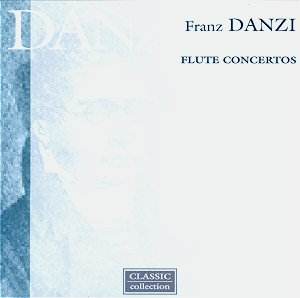Danzi's father was a cellist and as a teenager,
Danzi played the cello in the Palatinate court orchestra at Mannheim.
He remained there when the Electoral court moved to Munich. However,
in 1778 he went on to succeed his father as cellist in the court
orchestra in Munich. A prolific composer, he wrote chamber music,
orchestral music and as well as music for the stage. His career
as a composer continued in Munich with the performances of his
third German opera and he eventually went on to write some eighteen
stage works. He married a singer and continued an active career
in the opera house, leading eventually to his appointment as deputy
Kapellmeister in Munich in 1798. He returned to Mannheim after
his wife's death and went on to become Kapellmeister in Stuttgart.
Here he met the young Weber and had a stabilising effect on the
rather irresponsible young man. This, of course, has led commentators
to try and spot the older man's influence on the younger. In 1812
he moved to Karlsruhe where he was able to stage operas by Weber.
And in 1817 his singspiel 'Turandot' received its first performance
there.
Danzi was evidently a charming man and a fine
craftsman. His music reflects these qualities. Charming and civilised,
it makes up for what it lacks in depth with a winning melodiousness.
This well filled disc contains all of Danzi's Flute concerti in
recordings originally issued on the Orfeo label in the 1980s.
It remains the only recordings of these works in the catalogue,
though James Galway has recorded the Opus 31 work (on a disc coupled
with concertante pieces by Danzi for clarinet).
The first two concerti both date from around
1806 and the basic style is late eighteenth century classicism.
But the second concerto contains strong hints of Romanticism in
its orchestration particularly in the lyrical slow movement with
its two horns contrasting with the solo flute part. The last movement
is a lively Polacca, a form that was rather favoured by Weber.
The remaining two concerti date from around 1814. They represent
mature Danzi and are more strongly romantic in style. The third
concerto opens with a long introduction with plenty of orchestral
moments reminiscent of Weber. The slow movement contrasts the
limpid flute part with punctuating wind chords. The fourth concerto
opens with a wonderfully romantic slow introduction that is only
let down by the rather uninteresting figuration in the flute parts.
The middle movement is a charming piece for flute and a concertante
group of strings. This makes a fine contrast to the finale which
adds the surprise of brass instruments.
The flautist, Andras Adorjan, is a fine player
and has no trouble with the sometimes demanding writing. Unfortunately
the flute part, particularly in the earlier concertos, is apt
to rely too much on scales, passage work and arpeggios. Even in
the later concertos, much of the interest comes from the orchestra.
The orchestra, playing on modern instruments,
give a fine account of these works. Hans Stadlmair paces the movements
well and Adorjan rarely sounds rushed. Despite the use of modern
instruments, Stadlmair creates a welcome transparency in the orchestration,
allowing us to relish what is Danziís best feature in these works.
Whilst each concerto would be charming in a mixed
concert, at one sitting they do rather outstay their welcome,
as Danziís musical invention can wear thin. One longs for the
odd imaginative touch to develop in the way of Weber's concertante
works. But, this is an excellent CD just to dip into.
Robert Hugill
